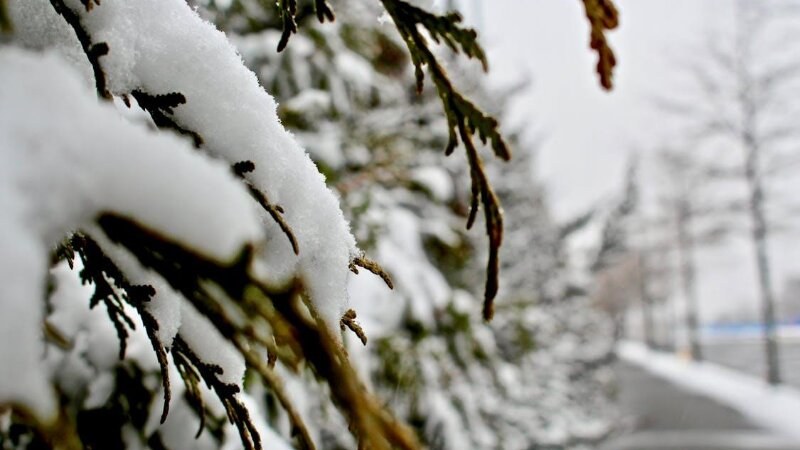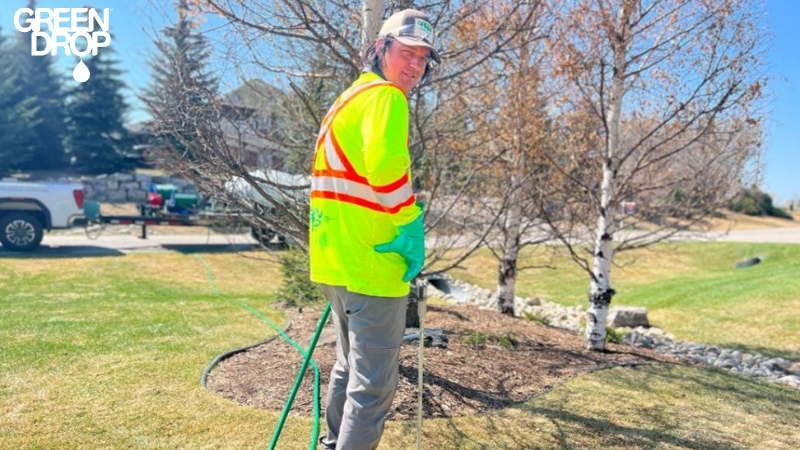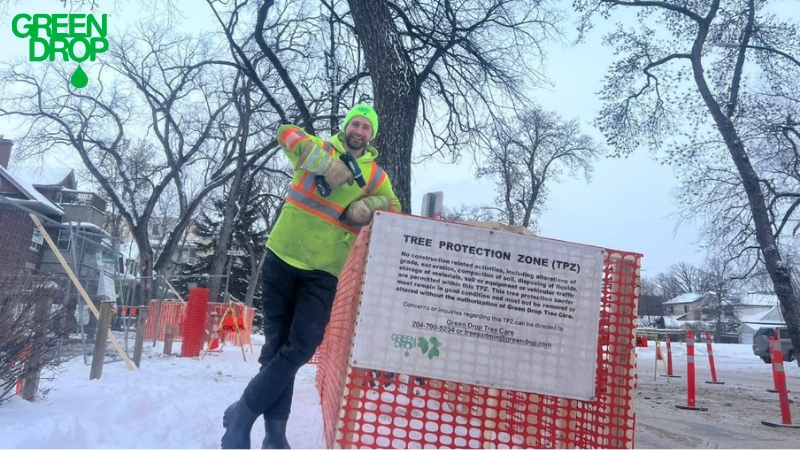What You Should Do To Prepare Your Evergreens for the Winter
Reading time: 7 minutesAs winter rolls in, it’s not just your wardrobe that needs some bulking up; your evergreens are hankering for some cold weather prep, too!
You might think these trees are built for winter. And you’re not entirely wrong. But just like us, these perennials find Western Canada’s winters a bit harsh on the limbs. And while this isn’t their first rodeo in the snow, your evergreens will appreciate all the help you can give them to strut their stuff come spring.
So, let’s get to it and prepare those evergreens for winter!

Water Wisely Before the Freeze
As winter approaches, giving your evergreens a good, deep watering sets them up for winter hibernation. Why is this important? Well, even though it might seem counterintuitive, winter can be a dry season for plants, especially when the ground is frozen solid.
Making sure your trees are well-hydrated before the freeze locks the moisture away and helps prevent them from becoming parched during the colder months. Think camels with their humps in the desert.
Remember: timing is crucial! Aim to water your evergreens thoroughly in late autumn, right before the first freeze is expected. This makes sure that the water has a chance to seep deep into the ground, reaching the roots where it’s needed most.
When watering, do so slowly and deeply, using a drip line or soaker hose around the base of the tree. You want to extend out to the edge of the branch spread. With this method, you can avoid wastage and ensure the water goes exactly where it's needed, without runoff.
Mulch to Manage Moisture
Mulch for evergreens right before winter is like the cozy blanket that you love snuggling into on a cold winter night. It's all about keeping the soil around your trees a bit warmer and significantly moist when the harsh weather hits.
Think of mulch as a barrier, one that locks in moisture and insulates the roots from extreme temperature fluctuations, which are all too common in our neck of the woods. The right kind of mulch can make all the difference.
Organic materials like wood chips, bark, or straw are ideal because they not only insulate but also break down over time to enrich the soil. We recommend using cedar or pine bark mulch for Calgary or Winnipeg’s climate. These not only complement the natural aesthetic of evergreens but are also excellent at maintaining soil temperature and moisture.
When applying mulch, aim for a layer about 2–4 inches thick. However, make sure to keep the mulch a few inches away from the trunk of the tree to avoid moisture build-up that could lead to rot. Spread the mulch evenly under the canopy of the tree, extending it slightly beyond the drip line. This area is where the tree’s feeder roots are most active and will benefit greatly from the protective and nutritive qualities of the mulch.

Shelter From the Elements
Winnipeg’s evergreens need more than just hopes and prayers to survive the notorious winter gusts and frosty temps. What they need is shelter—a defence against the elements.
For starters, consider erecting windbreaks. You can build these protective barriers using burlap attached to stakes positioned on the windward side of your trees. The stakes should be sturdy enough to stand up against the strongest of winds. The burlap forms a shield that cuts the wind without blocking all the sunlight.
Also, use sun shields—or as we like to call them—the Ray-Bans for your trees to protect against bright winter days. Direct sunlight can heat up the bark, causing cells to come out of dormancy and then rapidly refreeze once the sun sets, damaging the bark.
A simple burlap wrap around the trunk can prevent this. Let’s make sure it's loose enough to breathe but secure enough to stay in place (think snug scarf, not tight turtleneck). You want to position these wraps at the right height to cover the entire trunk from the base up to the first branches. This is crucial to provide optimal protection against fluctuating temperatures.
Keeping Winter Wildlife at Bay

In Winnipeg, the local wildlife (especially deer) seems to think your yards are their playgrounds. So, it’s imperative that you take steps to safeguard your evergreens from them. These winter nibblers can turn your majestic trees into half-eaten sculptures, which isn't the garden aesthetic most of you are going for.
First off, let's talk about barriers. A simple yet effective method is using stucco or chicken wire to create a physical boundary around your trees. Install a fence that stands about 1.5 to 2 metres high. Any lower and you can expect deer to jump over quite easily.
For individual trees, consider wrapping them in a sturdy wire mesh. Ensure it encircles the tree but doesn't rub against the foliage, preventing damage while deterring unwelcome diners.
If you're not keen on turning your yard into a prison yard, there are fewer fortress-like options. Deer repellents can also do the trick. Choose repellents that emit an odour unpleasant for deer but are not harmful to your plants or the environment.
Applications should be frequent, especially after heavy rains, to maintain effectiveness. Spraying the lower branches will usually suffice unless you're dealing with particularly determined or tall deer.
Bracing Evergreens with Support Structures

When Winnipeg’s skies unload their snow on our homes, the weight can be brutal on the less robust branches of our evergreens. It's vital to protect your younger, newly-planted trees to withstand the onslaught without bending or breaking.
Support structures can be a lifeline for these trees. Start by using soft, flexible ties, like cloth strips or special tree ties available at garden centres. Avoid using wire or anything that can cut into the tree bark and cause damage.
The technique here is to gently pull together the main branches and secure them in a way that maintains the tree's natural shape. At the same time, make sure you’re adding enough support to prevent sagging under heavy snow.
For columnar evergreens, like certain cedars and junipers, tying can be quite straightforward. Wrap the ties in a spiral up the tree, ensuring even spacing to distribute support evenly. This prevents branches from drooping while removing the risk of snow accumulating in the nooks of the tree, which can lead to breakage.
Setting up these supports in late fall, before the first major snowfall, is ideal. Once the ties are in place, give your trees a gentle shake after each snow to dislodge excess accumulation, just to be safe.
Post-Snowstorm Care
You can be sure that Winnipeg’s winter will whip up a snowstorm. And, once it’s done, your trees are left covered in snow. What now? Well, here are a few tips to handle post-snowstorm care to keep your evergreens healthy:
- Remove the Snow: After a snowstorm, gently remove snow from the branches of your evergreens to prevent damage. Use a broom with upward strokes to lift snow off the branches rather than pushing down, which can cause branches to break. For larger trees, you might use a long-handled brush or even gently shake the branches if the snow is light and fluffy. However, this can be dangerous and calling a certified arborist for this might be the best call.
- Inspection and Damage Control: Once the snow is cleared, inspect your evergreens for signs of bending or breakage. If branches are damaged, prune them to avoid further tearing which can invite disease. Also, check for signs of dehydration or desiccation, common in evergreens exposed to cold, dry winds and sun without adequate moisture.
- Ongoing Monitoring: Throughout the winter, keep an eye on your trees, especially after each snowstorm. Regular checks will help catch issues early, allowing you to act timely and prevent long-term damage.
- Protect from Weight of Snow: Notice your evergreens struggling with the weight of the snow or ice post-storm? Consider adding more temporary supports or wrapping for the most vulnerable trees. This can help distribute the weight more evenly and reduce strain on individual branches.

Protect Your Evergreens This Winter with Green Drop
As the chilly winds begin to become the norm and your evergreens puff out their chests bracing for the coming chill, don't let winter worries get you down.
At Green Drop, our ISA-certified arborists are seasoned in fortifying your foliage against the fiercest frosts. Whether you're in Winnipeg, Calgary, Edmonton, Red Deer, Regina, or Saskatoon, we're ready to provide tree health care services your greens deserve.
Why not book a free estimate today? Let us tailor a winter care strategy that ensures your evergreens continue to stand tall through winter and beyond.

